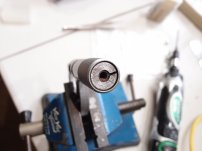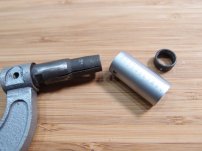If I recall correctly, Costco sold a Alltrade-branded, wooden-boxed set of a 1 inch micrometer and a 6 inch dial caliper in the late 1980s or early '90s for $US 35 or thereabouts. The quality of the set was similar to most of the Chinese-made micrometers and dial calipers sold in the U S under multitude of brand names.
My recollection is that the micrometer spindle / thimble interface is a self-holding taper. Removing the thimble from the spindle is pretty straight-forward: Use one had to grip the knurled portion of the thimble without covering the end of the thimble; lightly tension the taper by pushing the thimble away from the micrometer frame. Use your other hand to give the thimble end a moderate smack with a plastic screwdriver or small soft-face hammer. If it doesn't release at the first smack, a couple more will almost certainly free it.
My experience with these micrometers is that the spindle threads were nicely ground and then abused before they made it to the assembly separtment. The spindle nut thread is usually burred at the adjustment slits.
The spindle threads usually clean up nicely with an external hone (easily improvised) and a triangular jeweler's file can get rid of the slots in the nut.
The spindle taper will probably need a bit of smoothing; I use a diamond-grit "knife sharpening stone".
Spray-can carburetor cleaner is handly for cleaning off dried oil, but it will likely mess up the plastic insulator on the frame.
Once cleaned up and properly lubed (I've found 0w-20 full-synthetic engine oil to be entirely satisfactory), my experience is that these micrometers work well for normal use.
For the record, I've sent dozens of these and similar micrometers through an aerospace-hardware maker's calibration lab, and after that lab was shut down, through a commercial calibration lab. None of those micrometers were rejected.










